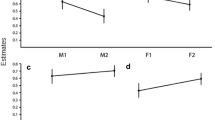Summary
Many stormpetrel species breed in habitats where their populations cannot be estimated by direct counts of burrows or birds; mark-recapture experiments have been confounded by the presence of many wandering non-breeders. With a population of Wilson's Stormpetrel Oceanites oceanicus at Bird Island, South Georgia, we tried to estimate the proportion of breeding females in samples obtained during a mark-recapture experiment. These were identified by measurements of the cloaca, which greatly enlarges at egg-laying. A concurrent experiment with individually marked birds determined that breeding females could be discriminated from males and non-breeders for c 30 days after laying. The technique is probably applicable to other petrels, though it will work best with those that lay most synchronously. The overall population estimate was 4841–5515 birds (SE 856–1417); estimates of breeding females gave a population of 2300 paris early in the incubation period and 1400 pairs near hatching.
Similar content being viewed by others
References
Beek JR, Brown DW (1972) The biology of Wilson's Storm Petrel, Oceanites oceanicus (Kuhl), at Signy Island, South Orkney Islands. Sci Rep Br Antarct Surv 69:54 pp
Begon M (1979) Investigating animal abundance. Edward Arnold, London
Copestake PG, Croxall JP (1985) Aspects of the breeding biology of Wilson's Storm Petrel Oceanites oceanicus at Bird Island, South Georgia. Bull Br Antarct Surv 66:7–17
Croxall JP (1984) Seabirds. In: Laws RM (ed) Antarctic ecology, vol. 2. Academic Press, London New York, pp 533–619
Croxall JP, Prince PA (1979) Antarctic seabird and seal monitoring studies. Polar Rec 19:573–595
Fowler JA, Okill JD, Marshall B (1982) A retrap analysis of Storm Petrels tape lured in Shetland. ringing and Migration 4:1–7
Furness RW (1984) Leach's petrel on St. Kilda. Br Ecol Soc Bull 15:84–87
Furness RW, Baillie SR (1981) Factors affecting capture rate and biometrics of storm petrels on St. Kilda. Ringing and Migration 3:137–147
Hunter I, Croxall JP, Prince PA (1982) distribution and abundance of burrowing seabirds (Procellariiformes) at Bird Island, South Georgia. 1. Introduction and methods. Bull Br Antarct Surv 56:49–67
Lacan F (1971) Observations écologiques sur le pétrel de Wilson (Oceanites oceanicus) en Terre Adélie. Oiseau Rev Fr Orn 41:65–89
Lack D (1968) Ecological adaptations for breeding in birds. Methuen, London
Love JA (1978) Leach's and Storm Petrels on North Rona 1971–1974. Ringing and Migration 2:15–19
Seber GAF (1982) The estimation of animal abundance and related parameters, 2nd edn. Griffin, London
Serventy DL (1956) A method of sexing petrels in field observations. Emu 56:213–215
Warham J, Wilson GJ (1982) The size of the Sooty Shearwater population at the Snares Islands, New Zealand. Notornis 29:23–30
Author information
Authors and Affiliations
Rights and permissions
About this article
Cite this article
Copestake, P.G., Croxall, J.P. & Prince, P.A. Use of cloacal sexing techniques in mark-recapture estimates of breeding population size in Wilson's stormpetrel Oceanites oceanicus at South Georgia. Polar Biol 8, 271–279 (1988). https://doi.org/10.1007/BF00263175
Received:
Accepted:
Issue Date:
DOI: https://doi.org/10.1007/BF00263175




